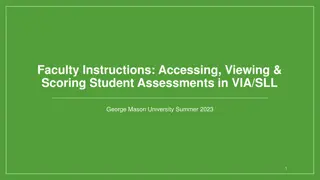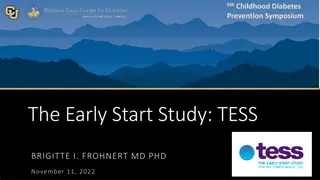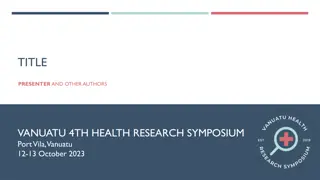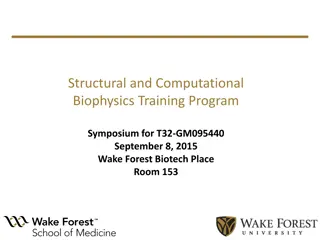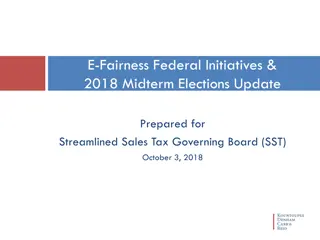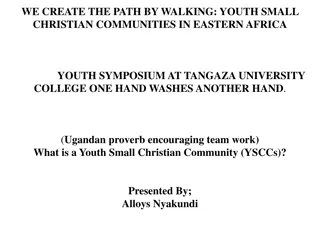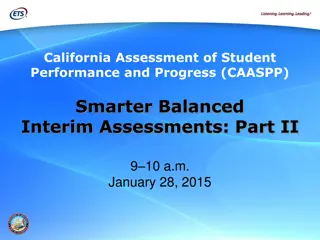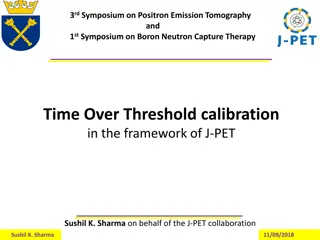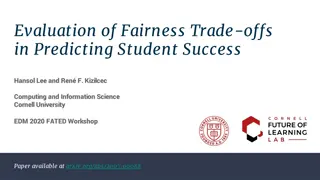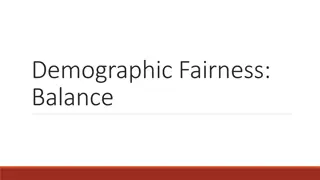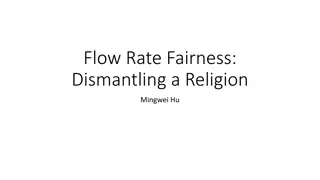Insights from Summer Symposium 2020: Assessments, Fairness, and Results
The Summer Symposium 2020 provided valuable insights on various topics, including assessments, fairness in grading, and looking ahead to results in the education sector. Key discussions included the process of awarding grades, ensuring fairness for all students, and considerations for interpreting and comparing exam results. The symposium emphasized the importance of unbiased judgements in assessments and highlighted key points for educators to consider when evaluating student performance.
Download Presentation

Please find below an Image/Link to download the presentation.
The content on the website is provided AS IS for your information and personal use only. It may not be sold, licensed, or shared on other websites without obtaining consent from the author. Download presentation by click this link. If you encounter any issues during the download, it is possible that the publisher has removed the file from their server.
E N D
Presentation Transcript
Summer Symposium 2020
Welcome Introductions and agenda Richard Garrett Welcome Roger Taylor Opening remarks Sally Collier Awarding 2020 Cath Jadhav, Michelle Meadows and Beth Black Appeals and autumn exams Julie Swan Questions and close Richard Garrett 2
Welcome Roger Taylor Chair, Ofqual Board 3
2020 opening remarks Sally Collier Chief Regulator 4
Awarding 2020 Cath Jadhav Director, Standards and Comparability Michelle Meadows Executive Director Strategy, Risk and Research, Deputy Chief Regulator Beth Black Director, Research and Analysis 5
The process this summer GCSE, AS/A level centre assessment grades and rank order, by subject. VTQs more varied approach, according to the qualification structure/purpose. Head of Centre declaration includes emphasis on objective judgements. Data now in substantial task for centres in current circumstances. 6
Fairness Approach this year is as fair as it can be. Fairness, particularly for those students with particular protected characteristics, at the heart of our decision-making. Our aim to support teachers in making unbiased judgements, so that the grades going into the statistical model were as objective as they could be: Judgements to be based on clear evidence we set out likely sources. Being mindful of, and minimising, the potential for unconscious bias we published guidance for teachers. 7
Looking ahead to results Provisional entry data entries stable this year. Points to note: Adjustments to GCSE French and German to better align with GCSE Spanish. National Reference Test we will consider the evidence this year, as in 2019. Expectation that results will look broadly similar to previous years nationally and at individual centre level because this is important for students and for public confidence in the qualifications. But there are some things to bear in mind 8
Interpreting results Every year, after provisional August results are published, reviews of marking and appeals have a small upward effect. Reviews of marking won t be available this year, but the historical data exam boards use will be final, not provisional. Important therefore to compare like with like in August: National data should not be compared with data from August 2019 it s very likely to show an increase, Centres should compare their results with those from 2019 after all reviews and appeals were resolved, and We will publish more data in August to contextualise the 2020 results. 9
The standardisation of GCSE, AS, A level, EPQ and AEA maths qualifications in summer 2020
The challenge this summer 1. Maintaining standards nationally so that the value of the qualification is the same this year, as last year and next year Outcomes this year will be broadly similar to those of previous years, if very slightly more generous 2. Setting comparable standards across centres - not possible to standardise across centres judgements in producing Centre Assessment Grades, a range of evidence will have been drawn on and a range of approaches taken As far as is possible, students won t be advantaged or disadvantaged by differences in the approach to estimating grades between different schools and colleges 11
The distribution of Centre Assessment Grades compared to last year s grades A level A* A B C D E 7.8 25.5 51.6 75.8 91.0 97.6 2019 13.8 37.8 65.0 87.0 96.5 99.7 CAGs +6.0 +12.3 +13.4 +11.2 +5.5 +2.1 AS level A B C D E 26.6 49.3 72.7 88.0 96.7 CAGs 20.1 +6.5 37.4 +11.9 56.9 +15.8 74.0 +14.0 86.3 +10.4 2019 GCSE 9 8 7 6 5 4 3 2 1 24.7 72.7 98.5 2019 7.7 17.6 31.6 48.5 66.4 82.4 92.5 97.3 99.5 CAGs +6.9 +9.7 +1.0 Data based on target age for qualification and on a like for like basis 12
Differences in the standards applied by centres The vast majority of centres have submitted optimistic Centre Assessment Grades, they will include: Those who genuinely believe their candidates would have performed better and they would have been correct, Those who genuinely believe their candidates would have performed better, but they would have been incorrect, A small minority who sought an advantage for their candidates. Impossible without exams to distinguish between these three groups of centres. Certain types of centres have submitted more optimistic Centre Assessment Grades than other types whereas in normal years patterns of improvement do not strongly vary by centre type (e.g. FE colleges, Comprehensives, Independent schools, Free schools, Sixth form colleges, Academies). The difference between CAGs and the average grades in 2018 and 2019 varied across centre type by between a fifth of a grade at GCSE and a quarter of a grade at A level. Underlines the importance of standardisation across centres so as to be fair to students 13
The aims of standardisation (abridged) upon which we consulted Grades candidates would most likely have received had they sat their exams A common standardisation approach to be used as far as is possible To protect, as far as possible, from systematic bias against different protected groups To be deliverable in a consistent way by exam boards and overseen by Ofqual To be transparent and easy to explain, wherever possible 14
Other questions upon which we consulted and decided Standardisation should put more weight on statistical evidence than Centre Assessment Grades where it will increase the likelihood of students getting the grades that they would most likely have achieved had exams gone ahead The trajectory of centres outcomes will not be taken into account because of the risk of unfairness The rank orders provided by centres should not be modified to take account of potential bias affecting individual candidates 15
Other decisions made through testing Selection of years of historical data on which to base the modelling: AS/A level 3 years of data GCSE 2 years of data where available for reformed specifications, a single year where it is not Tiering: Standardisation will operate across tiers with the data in a single model To retain of the rank order, candidates will be permitted to achieve grades that are off tier Decisions made in favour of students e.g. where cut scores fall within a group often students in a large centre the cut goes to the bottom national predictions exclude partially absent candidates and so are slightly more generous than they might otherwise be. 16
Testing to find the best standardisation model At the heart of the standardisation approach is a statistical model Tested 12 different approaches, predicting outcomes in 2019 Overall accuracy Accuracy for different types of centre e.g. FE colleges, Comprehensives, Independent schools, Free schools, Sixth form colleges, Academies Accuracy for centres with different proportions of candidates with protected characteristics (gender, ethnicity, EAL, SEND) and SES (IDACI, FSM) Selected the Direct Centre-level Performance (DCP) approach 17
The Direct Centre-level Performance approach 1. 2. 3. 4. 5. 6. 7. 8. 9. 10. 11. 12. 13. 14. 15. 16. 17. 18. 19. 20. 64HF7Y7KH43F 8J7489JDGTW7 MJ493827SB21 2394JD94JFJ9 4530JDHVNEM3 DH3756DHFJRK S4KE;SK36578 48374632HSK2 2847563JSCK3 273849EJDHVK 483746HDKSK3 SJDKFK3U7473 3747294N4HV5 265H463G4536 9485746HDG67 25463GFH643K 23645385DJG3 6473HD7362H3 362795HDJFJ5 AHDU57473829 1. 2. 3. 4. 5. 6. 7. 8. 9. 10. 11. 12. 13. 14. 15. 16. 17. 18. 19. 20. 64HF7Y7KH43F 8J7489JDGTW7 MJ493827SB21 2394JD94JFJ9 4530JDHVNEM3 DH3756DHFJRK S4KE;SK36578 48374632HSK2 2847563JSCK3 273849EJDHVK 483746HDKSK3 SJDKFK3U7473 3747294N4HV5 265H463G4536 9485746HDG67 25463GFH643K 23645385DJG3 6473HD7362H3 362795HDJFJ5 AHDU57473829 A B Candidates Candidates C D E Grades Grades Generate historical grade distribution for each centre Adjust the distribution to produce centre prediction Overlay the rank order onto the centre prediction Generate individual candidate grades Prior attainment data for candidates sitting in 2017-2019 Prior attainment data for candidates sitting in 2020 Results for candidates sitting in 2017-2019 Centre assessment grades Rank order 18
Centres with small numbers of candidates entered in a subject Confidence in the statistical evidence Balance of evidence E 19
Equalities analysis Analyses of the attainment gap for students with/without protected characteristics and of differing socio-economic status Analyses include: Gender, ethnicity, social economic status (FSM, IDACI), SEN 20
Equalities analysis initial findings for GCSE Gap in Mean Grade (9 to 1) 2018 2019 2020 Female > Male White > Black White < Asian English native < English as an Additional Language No SEN > SEN No FSM > FSM High SES > Low SES Low prior attainment: High SES > Low SES 0.48 0.13 0.39 0.05 1.57 1.15 1.09 0.48 0.49 0.15 0.46 0.07 1.54 1.15 1.08 0.48 0.50 0.19 0.40 0.00 1.50 1.16 1.03 0.42 Middle prior attainment: High SES > Low SES 0.52 0.50 0.46 High prior attainment: High SES > Low SES 0.65 0.61 0.58 21
Equalities analysis initial findings for GCSE Gap in Mean Grade (9 to 1) 2018 2019 2020 Female > Male White > Black White < Asian English native < English as an Additional Language No SEN > SEN No FSM > FSM High SES > Low SES Low prior attainment: High SES > Low SES 0.48 0.13 0.39 0.05 1.57 1.15 1.09 0.48 0.49 0.15 0.46 0.07 1.54 1.15 1.08 0.48 0.50 0.19 0.40 0.00 1.50 1.16 1.03 0.42 1/100th of a grade Middle prior attainment: High SES > Low SES 0.52 0.50 0.46 High prior attainment: High SES > Low SES 0.65 0.61 0.58 22
Equalities analysis initial findings for GCSE Gap in Mean Grade (9 to 1) 2018 2019 2020 Female > Male White > Black White < Asian English native < English as an Additional Language No SEN > SEN No FSM > FSM High SES > Low SES Low prior attainment: High SES > Low SES 0.48 0.13 0.39 0.05 1.57 1.15 1.09 0.48 0.49 0.15 0.46 0.07 1.54 1.15 1.08 0.48 0.50 0.19 0.40 0.00 1.50 1.16 1.03 0.42 1/100th of a grade Middle prior attainment: High SES > Low SES 0.52 0.50 0.46 High prior attainment: High SES > Low SES 0.65 0.61 0.58 23
Equalities analysis initial findings for GCSE Gap in Mean Grade (9 to 1) 2018 2019 2020 Female > Male White > Black White < Asian English native < English as an Additional Language No SEN > SEN No FSM > FSM High SES > Low SES Low prior attainment: High SES > Low SES 0.48 0.13 0.39 0.05 1.57 1.15 1.09 0.48 0.49 0.15 0.46 0.07 1.54 1.15 1.08 0.48 0.50 0.19 0.40 0.00 1.50 1.16 1.03 0.42 1/50th of a grade Middle prior attainment: High SES > Low SES 0.52 0.50 0.46 High prior attainment: High SES > Low SES 0.65 0.61 0.58 24
Equalities analysis initial findings for GCSE Gap in Mean Grade (9 to 1) 2018 2019 2020 Female > Male White > Black White < Asian English native < English as an Additional Language No SEN > SEN No FSM > FSM High SES > Low SES Low prior attainment: High SES > Low SES 0.48 0.13 0.39 0.05 1.57 1.15 1.09 0.48 0.49 0.15 0.46 0.07 1.54 1.15 1.08 0.48 0.50 0.19 0.40 0.00 1.50 1.16 1.03 0.42 1/25th of a grade Middle prior attainment: High SES > Low SES 0.52 0.50 0.46 High prior attainment: High SES > Low SES 0.65 0.61 0.58 25
Equalities analysis initial findings for A level Gap in Mean Grade (A*=6, A=5 ) 2018 2019 2020 Female > Male White > Black White > Asian English native > English as an Additional Language No SEN > SEN No FSM > FSM High SES > Low SES Low prior attainment: High SES > Low SES 0.07 0.33 0.14 0.17 0.09 0.30 0.33 0.17 0.10 0.36 0.19 0.20 0.02 0.27 0.34 0.20 0.16 0.35 0.16 0.13 0.11 0.28 0.29 0.12 Middle prior attainment: High SES > Low SES 0.18 0.19 0.17 High prior attainment: High SES > Low SES 0.17 0.20 0.13 26
Equalities analysis Initial findings show that the differences in outcomes for students with and without particular protected characteristics and of differing SES are similar to those seen in previous years Changes are very small and comparable to typical year-on-year fluctuations More in-depth analyses will be conducted and published 27
Calculated Results for VTQs this summer 28
Diversity of VTQ qualifications means a single methodology would not be appropriate Dimensions: Proportion of specific vocational or technical constructs versus general constructs Size Modularity/linearity Assessment design (internal versus external weighting) Number of pathways through Range of delivery models (timetabled; on-demand) Combinations of directly graded components and mark-based components. Grading structures (pass/fail; A to E; pass/merit/distinction etc) Aggregation algorithms. 29
Key guiding principle for calculated grades Evidence available to AOs in relation to different qualifications might include: Banked components Internal assessment grades not yet moderated CAG/rank orders Historical centre profiles Historical qualification data (intra qualification/sessional Prior attainment. Key principle: AOs design an approach which maximises the most trusted evidence in the context of particular qualifications. 30
Calculation approaches for VTQs this summer Identify available evidence and evidence that could be collected Devise an approach which maximises use of most trusted evidence Evaluate trust in each source of evidence Implement the approach 31
Calculated Result the 3 element blueprint Centre Assessment Grade; and/or AO calculated grade Overall check on outcomes Quality Assurance The approach will depend on the context of the qualification, availability and levels of trust in different sources of evidence. 32
Ofquals role Extraordinary Regulatory Framework flexibility to allow AOs to adopt the most appropriate approach. Oversight on technical approaches, helping to ensure AOs are making sensible decisions, maximising use of most trusted evidence: Banked evidence and filling in the gaps AO calculated grades versus Centre Assessment Grades Most suitable approaches to quality assurance NB for qualifications most similar to GCSE/A levels, AOs may choose to adopt a similar approach. Oversight on overall outcomes. Equalities analyses. 33
Appeals and autumn exams Julie Swan Executive Director, General Qualifications 34
GCSE, AS and A level appeals and autumn exams Summer symposium 2020
Context When the Secretary of State directed Ofqual to have regard to the government s policy on 31 March he said: It is important that students should have access to a right of appeal if they believe the process was not followed correctly in their case. Ofqual should therefore develop such an appeal process, focused on whether the process used the right data and was correctly applied, rather than seeking to overturn teachers professional judgement on individual students ability. He also told us that: The Government considers that students who do not feel their calculated grade reflects their ability should be afforded an opportunity to sit an exam at the earliest reasonable opportunity. And asked us to work with the exam boards and others to plan to enable this group of students to sit exams as soon as reasonably possible after schools and colleges are open again .. 36
This years arrangements In a normal year students demonstrate their ability by taking exams If they believe their work hasn t been accurately marked their centre can ask for the marking to be reviewed This year students haven t taken exams so there s no marking to review Students will be able to ask their centres to appeal to the exam board if it seems something went wrong when their grades were calculated Students who believe their grade doesn t reflect their ability will also be able to take exams in the autumn For a small number of students the autumn exams will be the only opportunity to achieve a grade this year, as they were unable to receive a calculated grade Different options for VTQs 37
Appeals We confirmed in May that a centre may appeal to the exam board if it believes the centre itself made an error when submitting a centre assessment grade or rank order information; or it believes an exam board made a mistake when calculating, assigning or communicating a grade. We expect that any such mistakes will be quickly found and corrected. We considered whether students should be able to challenge their centre assessment grades and position in their centre s rank order. We decided it would not be in the interests of students or the fairness of the arrangements overall. We do not believe there is anyone who is better placed than the student s teachers to provide a centre assessment grade 38
Considering a further ground of appeal We also said we would consider whether to allow an appeal where a centre could show evidence of a significant demographic change in its cohort sufficient to justify a change to the standardisation process Our analysis indicates such cases would be exceptional because such changes are rare and the magnitude of change that would be required to affect the calculated grades would need to be large We concluded that such a demographic change would amount to using the wrong data for the purposes of standardisation. Centres will be able to appeal on these grounds, so no additional provision is needed 39
Statutory guidance We have consulted on draft statutory guidance on appeals and we re reviewing responses. The guidance explains who we expect exam boards to handle appeals this summer. In particular: the minimum information which we consider an awarding organisation should provide to schools and colleges to allow them to consider whether to appeal, and further explanation and exemplification about appeals on the basis that the wrong data was used for the purposes of standardisation. Examples of use of the wrong data include where a school or college has had a significant change its circumstances and it has evidence to show how some or all of its historical data is an unreliable predictor of its students performance this year. This might be, for example, because of a big shift in the demographic makeup of the cohort or a particularly significant event that affected a previous cohort. The centre might argue that a more limited range of historical data is used. We will to publish the final guidance before the end of the month. Exam boards will also publish details of the appeals process 40
Concerns of bias or discrimination Any concerns about bias, discrimination or any other factor that suggests that a centre did not behave with care or integrity when determining the centre assessment grade and/or rank order information should be raised in the first instance with the centre or with the exam board directly Where there is evidence, exam boards must investigate allegations as potential malpractice or maladministration. Such allegations would be very serious, and we expect them to be rare, but this is an important safeguard for students and their overall confidence in this year s grading arrangements. 41
An autumn series for GCSEs, AS and A levels We had about 3,500 responses to our consultation on the autumn. The great majority agreed that exam boards should offer the full suite of exams, with the same number and format of exams as in any normal series. We have confirmed an autumn series on this basis. The normal review of marking and appeal arrangements will apply. While it would be desirable for the autumn series to include non-exam assessment, in line with our consultation proposals, with the exception of art and design, grades will be based on exam performance alone. Apart from art and design there will be no non-exam assessment (NEA). 42
Non-exam assessment NEA is used to assess subject content that cannot be assessed in exams. However, it will be difficult to manage for many subjects in the new academic year. There are concerns that basing grades on exam performance alone will disadvantage some groups of students, including those with special educational needs. But our research about the impact of coursework on different groups of students, found variation in GCSE and A level grade outcomes is largely explained by students prior attainment. It finds little evidence that coursework has any impact on outcomes for students with special educational needs. . 43
Further details In light of feedback we will require exam boards to provide a new certificate on request if a student s grade changes following the autumn exams The exam boards have now confirmed the exam window - AS and A levels in October and GCSEs in November Entry will be limited to students who had entered for the summer exams and to students who the exam boards are confident had intended to enter for them and to students who would normally be eligible to take GCSEs in English language and maths in November We understand the logistical challenges schools and colleges will face in the autumn. The Department for Education is exploring ways to minimise the burden on centres. 44
Information for students We will publish next week a guide for students that sets out how their grades will be calculated this year and what to do if they think something went wrong with the way their grade was determined We will signpost students to sources of support and advice, including to our own helpline and to the National Careers Service s Exam Results The guide will include information about the autumn exams 45
Questions? 46
Links to information covered today to be sent to you by email Ofqual s Summer Series Symposium News story Statistical Model factsheet Model animation The Symposium slide pack Guidance for teachers, students, parents and carers: Summer 2020 grades for GCSE, AS and A level, Extended Project Qualification and Advanced Extension Award in maths Information for Heads of Centre, Heads of Department and teachers on the submission of Centre assessment grades: Summer 2020 grades for GCSE, AS and A level, Extended Project Qualification and Advanced Extension Award in maths Guidance for teachers, students, parents and carers: Summer 2020 results for vocational, technical and other qualifications Inter-subject comparability in GCSE modern foreign languages Collection National Reference Test: information 47
Questions and close Richard Garrett Director of Policy and Strategic Relationships for GQ 48


